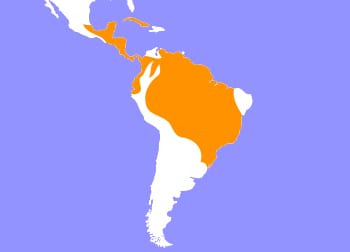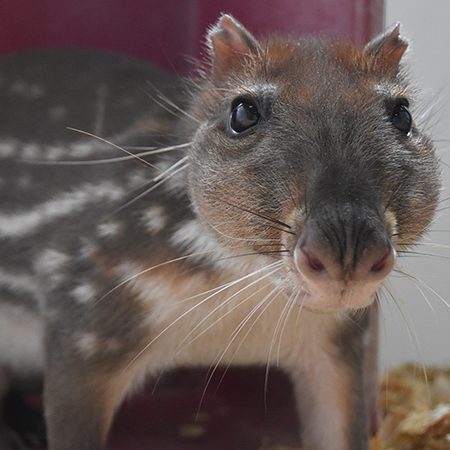Paca
Cuniculus
A paca is a ground dwelling, herbivorous rodent native to South America. They can be physically described as a large rodent with dots and stripes on their sids, short ears, and a barely visible tail. A few other names the furry creatures are referred to are “gibnuts” and “royal rats”. Pacas are 20 to 30 inches in length, weighing between 10 - 30 pounds, and are the sixth-largest rodent in the world. They are physically described as having square heads, small ears set on top of their heads, and virtually invisible tails. Their bodies have large hind limbs, small fore limbs, and cone-shaped bodies. In the wild they can live up to 13 years.
In the tropics of South America, Pacas inhabit rainforests, cloud forests, and sometimes more open field areas. They have been observed swimming and prefer to be near water. Pacas will build their burrows near water, they can be up to 9 feet deep, normally with two entrances and multiple exits. When threatened they will dive into the water and can stay submerged up to 15 minutes. Additionally they can vertically jump up to 1 meter, and stand still up to 45 minutes, these impressive skill sets help them escape predators. They are normally passive in the daytime and forage in the morning and afternoon, but can be strictly nocturnal in areas with many predators.

Pacas are found in parts of Mexico and South America. They have since been introduced to the Bahamas, Cuba, and Jamaica.
HABITAT -They inhabit rainforests, cloud forests, and open fields of Central / South America.
DIET -They eat fruits from trees close to the canopy floor, leaves, flowers, fungi, and insects.
FUN FACT -They can be slow on land but are excellent swimmers, being able to stay submerged up to 15 minutes.
SOCIAL BEHAVIOR -They are monogamous animals and a pair will mate and live together for life.
ACTIVITY -Pacas are mostly nocturnal, being active during the evening and sleeping during the day.
PREDATORS -Predators of the Paca include the cougar and jaguar, as well as habitat loss from humans.
SIZE -Pacas are 20 to 30 inches in length, weighing between 10 to 30 pounds.
RELATIVES -In the genus Cuniculus they are related to the mountain paca.
CONSERVATION -Pacas are categorized as LC (Least Concern) species by the IUCN.
Cub Creek Animal Care Information
Housing - Here at Cub Creek our Paca lives in a large open environment called the Pentagon. Living in the Pentagon, he has open room to graze surrounded by trees. They have access to a few large hide spaces, where they spend most of their day. They always have access to clean water, and a small pond for swimming and cooling off. The pentagon is a multi species enclosure, giving it a more simulated environment living with our Patagonian cavies, tortoises, and wallabies!
Diet - Our Paca eats a diet consisting of mostly fruits, just like they would in the wild! Our paca loves eating apples, bananas, sweet potato, various greens, and other mixed fruits and veggies. This mixture of food provides adequate nutrition to keep them happy and healthy. Our Paca also enjoys special fruit treats!
Enrichment - Since our Paca stays in his hide most of the day, they don’t get very much social time with campers. However, that doesn’t stop campers and us from giving him plenty of love and attention! Campers will create hides and other structures for them to play on out of cardboard. Campers have also made them frozen fruit treats they love! As well, living in a multi species enclosure helps to promote socialization.


